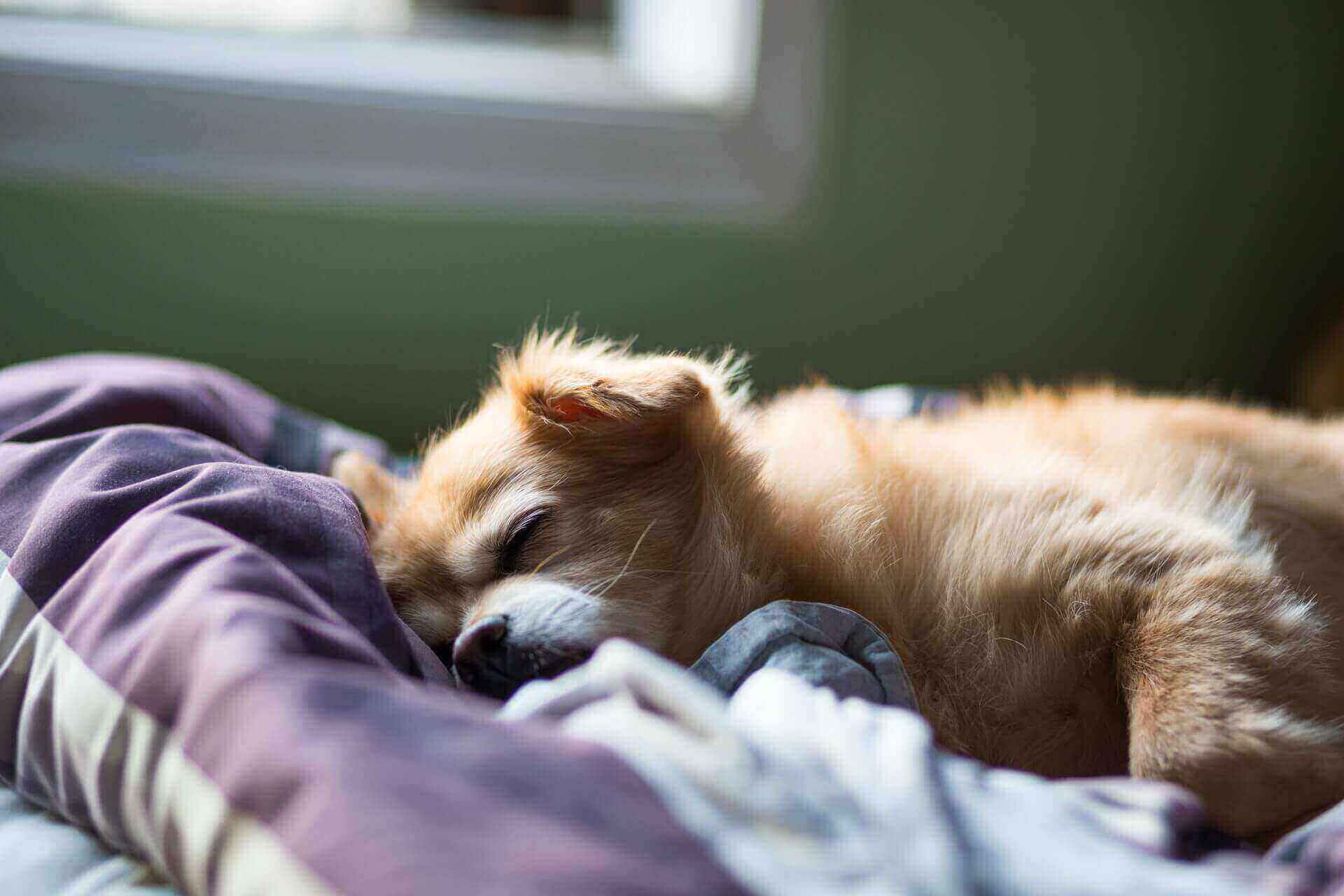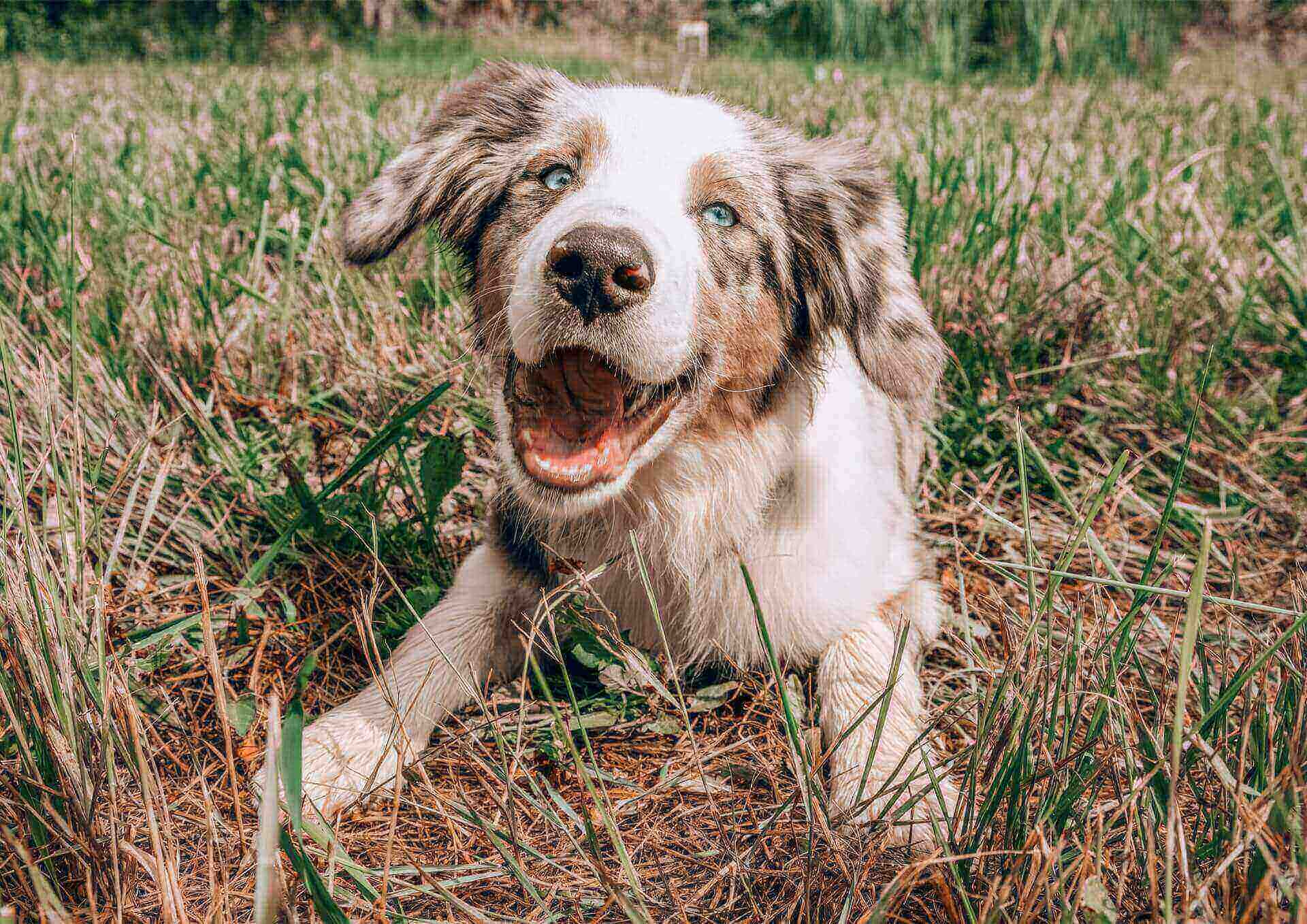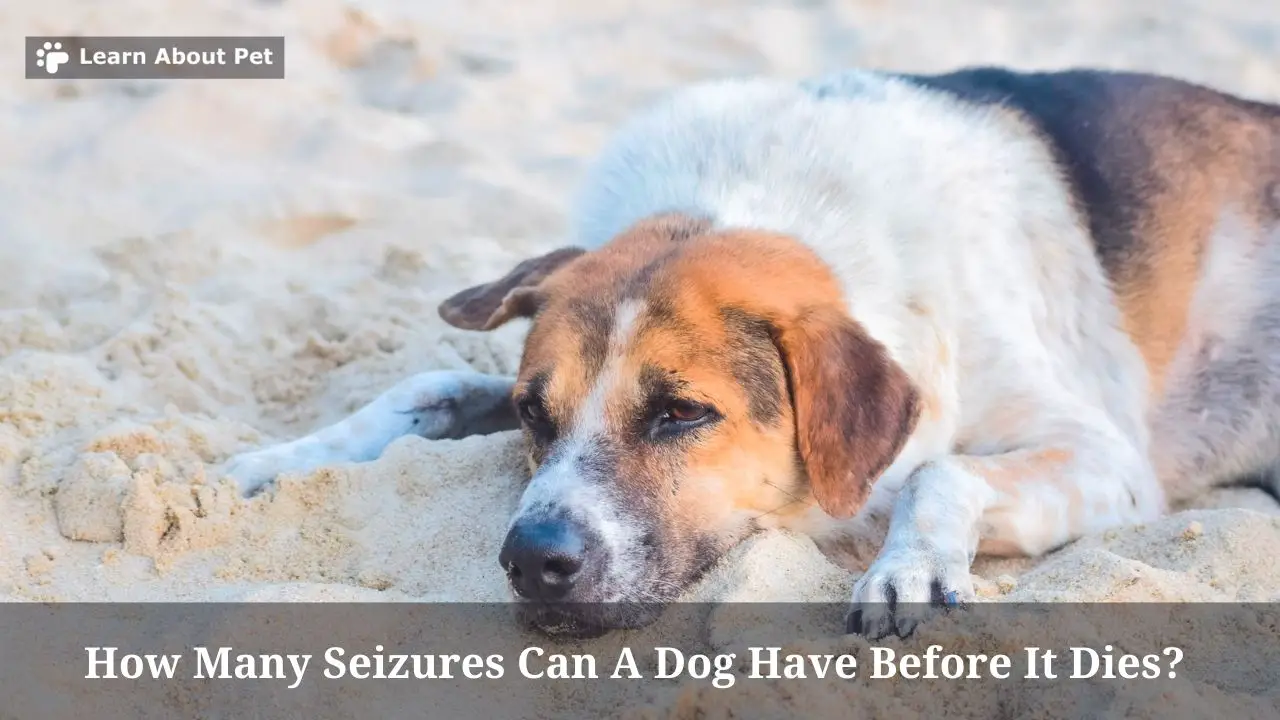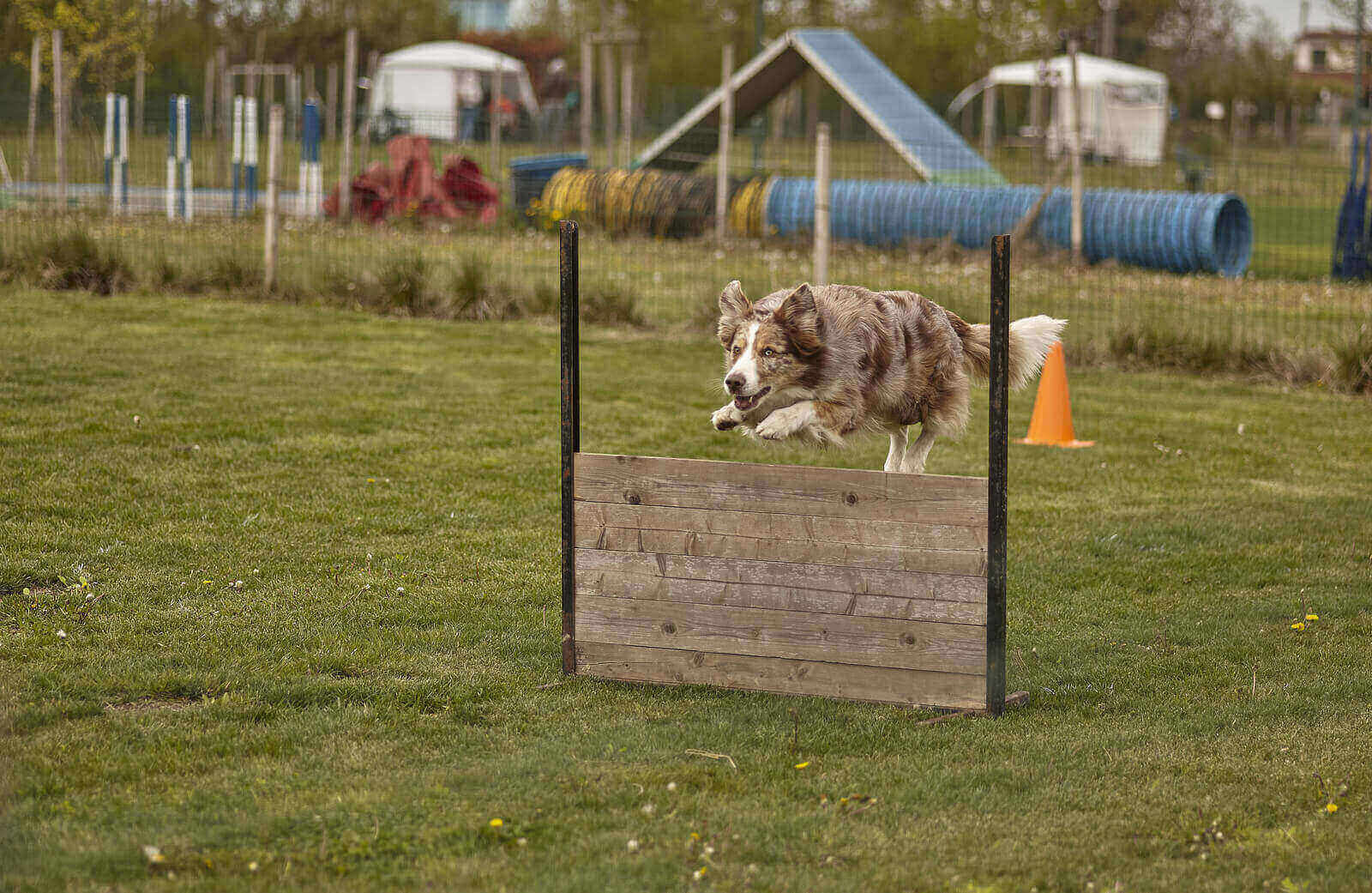Just like us, dogs enjoy taking a nap. The dog twitching in sleep is usually normal behavior. Only in rare circumstances, it may mean that the dog is having a seizure. Just make sure your dog is not showing any illness symptoms.
Is Dog Twitching In Sleep Normal?
Did you ever wonder about dog twitching in sleep? You are not alone. It is wondrous to consider the fact that dogs dream as we do. The involuntary muscle movements happen because of actions in dreams.
Here’s the explanation for dog twitching and flinching in sleep. When dogs sleep, their brains shut down all major muscle movements. If that would not be, then dogs would act out all their dreams with vigorous movement.

However, deep up in the brainstem, is a part called the Pons. This part of the brain consists of two ‘off switches’. These regulate muscle movement during dream sessions.
As it happens, in certain situations these ‘off switches’ remain partially active. This effectively leads to dog twitching in sleep.
This is particularly true for puppies where the pons is yet to develop fully. As for senior dogs, aging tends to hamper the full-fledged functions of the brain. That’s the explanation for an old dog twitching in sleep.
This conclusion has been derived from the research of Dr. Stanley Coren. No one can say for sure what dogs dream about. We can only make smart guesses about dog twitching in sleep.
Nevertheless, researchers know for certain that dogs do dream. Their eyes display similar rolling movement as we do when we dream. Studies on REM (Rapid Eye Movement) sleep in dogs are still largely inconclusive
As dog twitching in sleep increases with age, you may find it as a new behavior. There is nothing to worry about. That said, you should remain informed about the symptoms of your dog having a seizure.
What Do Dogs Dream About?
Sleeping is composed of two distinct stages. These are NREM (Non-Rapid Eye Movement), and REM sleep. Most dogs spend about half of their day sleeping. A large part of this is REM sleep. That’s the reason why we often see a dog twitching in sleep.
Here’s the difference between the two stages of sleep. Just like us, a dog’s brain alternates between these two stages.
| NREM sleep | REM sleep |
| It is the initial sleep cycle. | It follows NREM sleep. |
| Consists of three stages, N1, N2, and N3 | Subsequent cycles get longer and can last up to one hour |
| The body exhibits non-rapid eye movement | The body exhibits rapid eye movement |
| It consists of partial wakefulness (stages N1 and N2). It may consist of voluntary movement. | The body is in deep sleep. It’s difficult to wake up. It consists of involuntary movements like a dog kicking back legs while sleeping. |
| No dreaming | The mind experiences vivid dreams. It consists of movements like dog twitching in sleep and licking. |
| Strengthening of the immune system | Associated with the learning center of the brain |
Just like us, dreaming in dogs is a way of processing memory functions. These show up as complex subconscious hallucinations projected on the mind’s eye.
Let’s face it. Despite all our scientific advancements, dreaming is an everyday mystery. It’s just why it is impossible to fully explain a dog twitching in sleep.
We can only guess that our furry friends are dreaming good dreams. Dog twitching in sleep nightmare is also a possibility. Did you ever notice fearful behavior in your dog just after he woke up? The only probable explanation is that your dog has had a nightmare.
Why Does My Dog Twitch So Much In His Sleep?
As long as it’s not a seizure, there is nothing to worry about. The phenomena of a dog twitching in sleep is a perfectly normal mystery. You can safely infer that your pet is a vivid dreamer.
You can also assume that your pet goes through life experiences intensely. After all, most theories about dreaming support that it comes from everyday experiences.

As a corollary to this, you can also assume that you own a highly sensitive animal. It might also mean that your pet is deeply attached to you.
If your dog twitching in sleep is in excess, do not try to wake him up. Let him chase the dream squirrel in a wide, open surreal field of grass.
Suddenly waking up may result in your dog scratching or biting you. If you do want to wake him up, call his name loudly. You can also try making a sudden loud noise in front of your sleeping dog. Reassure him if he wakes up startled.
Why Does My Dog Sleep With Open Eyes?
Did you ever pass by your resting dog and wonder about his blank stare? You proceed to pet him. Suddenly, it dawns on you that your pet is fast asleep.
Many pet owners ask about dog twitching in sleep eyes open. It’s something quite common to notice as well.
This is an evolutionary trait in dogs. As their ancestors lived in the wild, nature granted them this strange ability. It seemed to show that they are awake. This helped them to be safe from predators when they slept.
Hundreds of generations later, many domesticated dogs still retain this trait. It is particularly visible in breeds with high prey drive. Guarding breeds also show this trait. That’s why you see a boxer dog twitching in sleep with eyes open.
Admittedly, combined with dog twitching in sleep, it may seem like an eerie behavior. But, it’s nothing that the dog can control voluntarily. If you observe a dog twitching in sleep eyes slow breathing open, do not worry.
“Why is my dog twitching awake?”
Also, note that the seemingly open eyes might actually be closed. You are perhaps seeing the pinkish nictitating membrane covering the dog’s eyes.
This third eyelid closes laterally from the sides when the dog is resting. It is also an involuntary action. The nictitating membrane keeps the eyes moist. It also removes debris from the eyes.
It automatically becomes active when the eyes roll back into the sockets. The gland associated with this membrane produces tears. So, it must remain active.
Lagophthalmos refers to the inability to close the eyes completely. Brachycephalic breeds typically have this anatomical issue.
Cherry Eyes For Dog
In this instance, a dog twitching in sleep with open eyes may indicate a problem.
It happens when the cartilage supporting your dog’s eyes falls over. This results in the inability to close their eyes completely. You may want to talk to the vet about this. There might be a surgical solution to this problem.
In this context, dog twitching in sleep after surgery is also normal behavior. Let your dog sleep easy.
What Does A Dog Seizure Look Like While Sleeping?
How to tell if a dog is having a seizure while sleeping?
In rare circumstances, twitching in sleep may be caused by a seizure. Usually, it’s more violent than twitching. The dog may drool, defecate, or urinate.
It can last from a few seconds to several minutes. Following a seizure, the dog will look disoriented. He may display highly erratic behaviors such as pacing. He may also suffer from temporary blindness.
“Why does my puppy shake violently while sleeping?” If the twitching is violent, chances are that your pup has epilepsy. You should observe all the associated symptoms of a seizure, and notify the vet.
Every dog owner should keep an open eye on the possibility of their pets having a fit of epilepsy. Although it is a rare condition, yet it is not uncommon.
Stages Of Dog Seizure
A seizure consists of three stages. You need to be familiar. These should help you identify whether it’s a dog twitching in sleep or seizure.
The first is the pre-ictal phase. During this, the animal instinctively senses that a seizure is about to occur. He may display behavioral changes like abrupt barking, whining, or shaking. The dog may try to seek out the owner or hide somewhere.
Next, is the ictal phase or the actual time of the seizing. The dog will usually fall to his side and shake uncontrollably. His legs will exhibit a vigorous paddling action. It is not like the usual harmless dog twitching in sleep. The head of the dog will automatically stretch backward.
If it lasts for more than 5 minutes, the dog may lose consciousness. It is a very serious stage called status epilepticus. You should contact the vet as soon as possible.
The last stage is the post-ictal phase. The dog will regain his normal bodily functions but will be dazed. Nothing like this happens following the normal dog twitching in sleep.
Types Of Dog Seizures
Focal seizures affect only a particular portion of the brain. The dog will have convulsions on one side of his body. It can last for a few seconds. Occasionally, it progresses to more serious grand mal seizures.
Grand mal is also known as a ‘generalized’ seizure. It affects the entire body. It is a far cry from the simple dog twitching in sleep.
Besides these two types, the dog might suffer from idiopathic epilepsy. There are no known causes of these kinds of epileptic fits. You should be aware of the symptoms of dog twitching in sleep a concerning epilepsy.
Also, the dog may suffer from a psychomotor seizure. It is difficult to identify because the dog will not collapse to the ground.
Instead, he will display erratic behavior like chasing the tail frantically. You should notice whether your pet is showing signs of losing his orientation. Is he not having fun chasing the tail, but doing it compulsively? It might be a seizure.
What Should You Do When Your Dog Has Seizure?
Pet-parents often ask about dog twitching in sleep what to do. However, that’s not the question you should be asking. The typical dog twitching in sleep is normal and shows that the dog is dreaming.
What you should ask is what to do when your dog is having a seizure. You must follow certain precautions.
If your pet is in an elevated place, you should gently carry him to the open floor. This should save him from getting hurt from falling.
Remember that there is no need to put anything in the dog’s mouth. It is a myth that their tongues roll back to the neck. The seizing dog may uncontrollably bite your finger.
You should be speaking softly to your pet. Calm him down by gentle petting once the dog twitching in sleep seizure is over.
If possible, time the seizure. Keep a visual note of all the symptoms. Report them to the vet. In serious situations, the doctor may prescribe anti-convulsive medication.
Do note, anti-convulsive medication, once started, must continue for life. Withdrawal from them can cause seizures. If your pet is already taking any medication, don’t forget to report it to the vet.
Also, do not ever feed xylitol, or caffeine to your pet. Dark chocolate must be strictly avoided. These apparently harmless food items can lead to seizures in dogs.

Takeaway – Dog Twitching In Sleep
It is perfectly common to watch a big or small dog twitching in sleep. They are just dreaming. Show enough love and pet your dog often. There is no reason to worry.
That said, you should be familiar with the symptoms of a seizure. In that case, the vet will look into the matter.
Here’s hoping that your dog never has a seizure.

Welcome to Learn About Pet. My name is Rajkumar Ravichandran and I love all pets, travel, and amazing food. I write about my passion and personal experience caring for multiple pets in this blog! ❤️
Post Disclaimer
DISCLAIMER: THIS BLOG OR WEBSITE, "Learn About Pet", DOES NOT PROVIDE YOU WITH MEDICAL ADVICE AND IS NOT A SUBSTITUTE FOR MEDICAL ADVICE. ALWAYS GET IN TOUCH WITH YOUR PERSONAL VETERINARIAN AND USE INFORMATION HERE AS GENERAL ADVICE.
The information, including but not limited to, text, graphics, images and other material contained on this website are for informational purposes only. No material on this site is intended to be a substitute for professional veterinary advice, food recommendation, diagnosis, or treatment. Always seek the advice of your veterinarian or other qualified health care provider with any questions you may have regarding a medical condition or for pet food related questions.







